The economic calendar is normal including reports on home sales, consumer confidence, personal income and spending and jobless claims. The final revision of Q1 GDP will be of less interest. While there is growing interest in economic data, most investors and analysts know that the threat from COVID-19 has not ended. Bloomberg Businessweek’s cover story about The Great Disconnect.

The most important question remains:
How should investors interpret the mixed economic and market messages?
Last Week Recap
In my last installment of WTWA, I asked whether investors could depend on the rebound trend. So far, so good. The list of “propositions to consider” will be a good touchstone in a few months. With my vacation at an end, today’s post provides a better opportunity to examine these questions more completely.
The Story in One Chart
I always start my personal review of the week by looking at a great chart. This week I am featuring Investing.com’s version. It has many interactive features including the news indicators which I can show only in static form. I am also showing both the S&P cash version and the S&P futures version, illustrating how different the world looks when watching continuous trading.

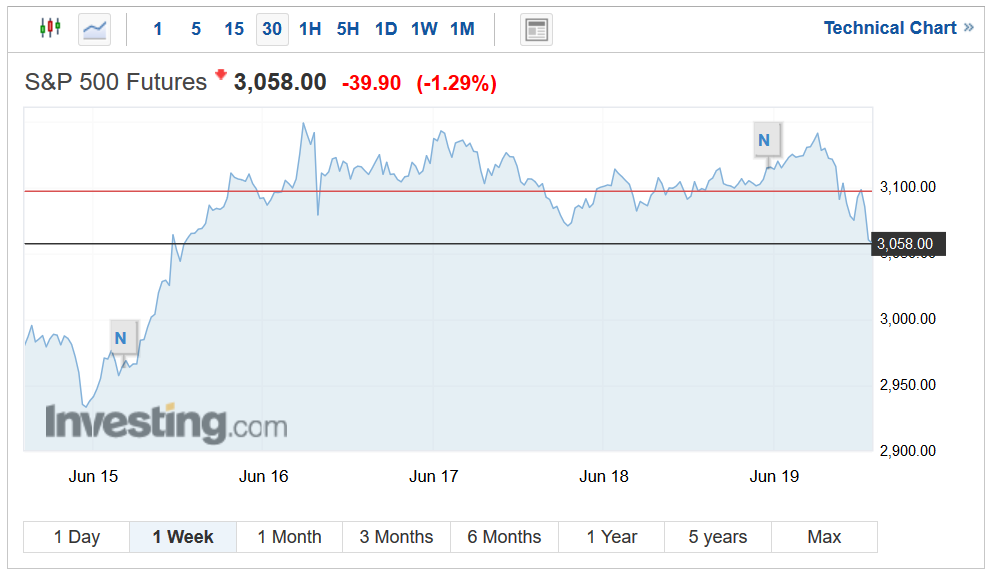
In the latter chart we can see some big moves from overnight highs and lows as well as larger daily changes. While there is an active arbitrage trade between futures and cash, the futures react to events more quickly.
On a cash basis, the market rose 1.9% on the week and the trading range was 6.4%. My weekly indicator snapshot monitors the actual volatility as well as the VIX (see below).
Here is the updated tracking for sectors. Consumer staples, health care, and utilities are especially interesting.
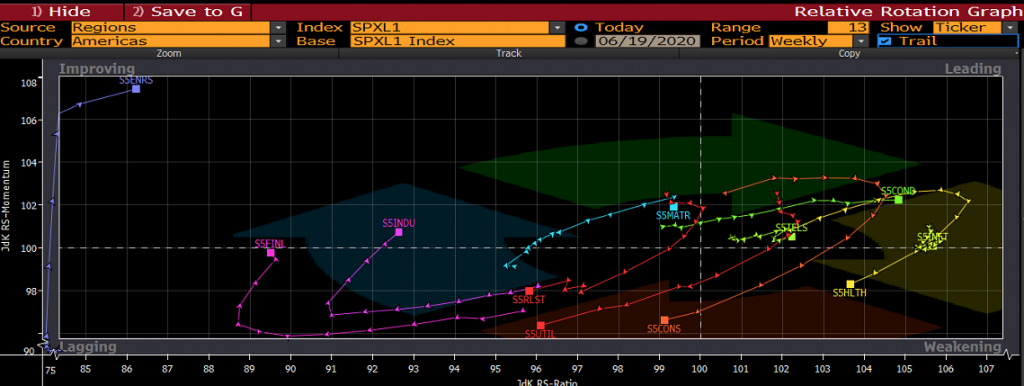
Noteworthy
Tesla (NASDAQ:TSLA) is now “the world’s most valuable automaker.” Visual Capitalist compares the companies with a comment on many of them. Take note especially of the irrelevance of actual vehicle production numbers.

The News
Each week I break down events into good and bad. For our purposes, “good” has two components. The news must be market friendly and better than expectations. I avoid using my personal preferences in evaluating news – and you should, too!
New Deal Democrat’s high frequency indicators have always been a valuable part of my economic review. They are especially important as we all try to monitor the economic recovery. His three time frames all show some improvement – positive in the long-term, neutral in the short-term, and “less awful” in the nowcast. NDD warns that this all depends “on the trajectory of the coronavirus pandemic.”
The Good
- Empire State Manufacturing recorded a June reading of -0.2 versus expectations of -25.0 and May’s -48.5.
- Mortgage applications rose 8.0% a bit lower than the prior 9.3% gain, but still very good. Scott Grannis writes, The housing market is alive and well. He notes the relative strength of homebuilding stocks.
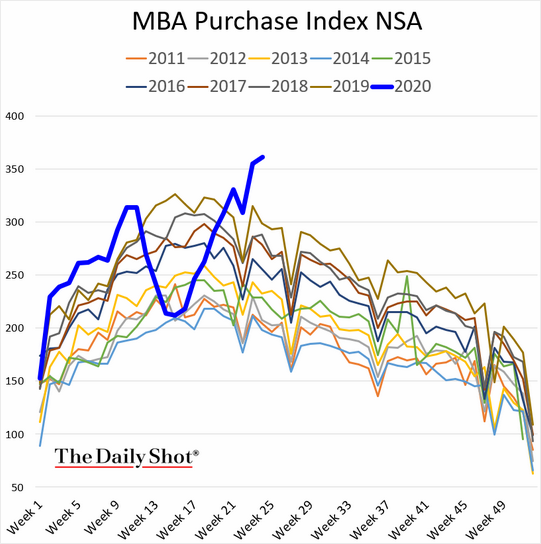

- Builder Confidence for June was 58, up from 37 in May. (Calculated Risk)
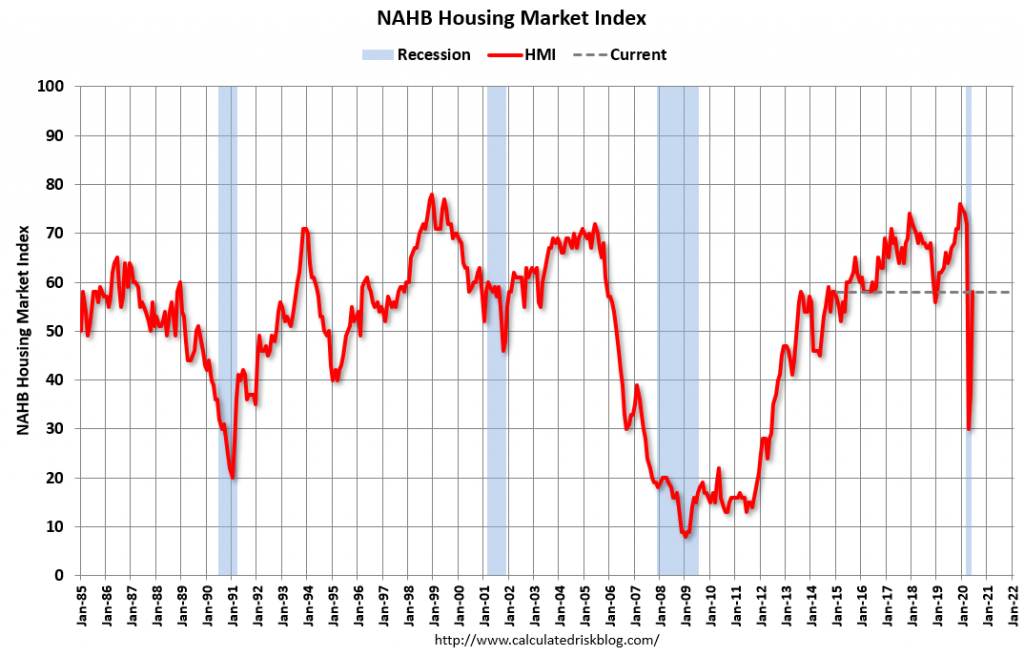
- The Philly Fed Index for June was 27.5 versus expectations of a 25-point decline and May’s reading of -43.1.
- Household rent payments remain comparable to 2019, at 89.0% for June. (Calculated Risk).
- Earnings estimate revisions are improving. (Brian Gilmartin). Read the entire post for excellent detailed commentary on a topic that deserves more attention.
- Leading economic indicators for May increased 2.8% versus expectations of 2.5% and a big improvement over April’s decline of 6.1%.
- Rail traffic shows a “slight improvement.” (Steven Hansen, GEI).
- Retail sales for May surprised with a gain of 17.7%. Expectations were only for a 5.2% pop and April registered a 14.7% loss, revised down from -16.4%. (Jeff Bartash, MarketWatch).
The rebound in sales largely reflects the loosening of restrictions on business activity after two months of stay-at-home orders to combat the coronavirus pandemic. Along with pentup consumer demand, federal tax payments to families and more generous unemployment benefits also helped stoke higher sales.
Yet even after the rebound in May, sales were still 6% lower compared to the same month in 2019, showing the lingering damage caused by the lockdown of the economy.
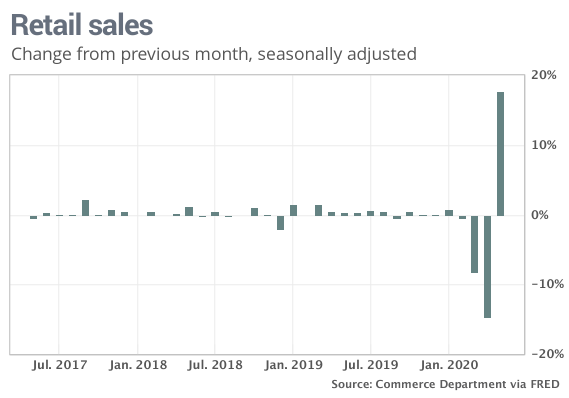
The Bad
- Industrial production increased 1.4% in May, missing expectations of a 3.0% gain but a vast improvement over April’s 12.5% decline.
- Housing starts for May increased 974K (SAAR), lower than the expected 1170K but better than April’s (upwardly revised) 934K. Calculated Risk expects a “significant increase in single family starts over the next couple of months.”

- Initial jobless claims remained elevated at 1.508M versus expectations of 1.350M but slightly better than the prior week’s 1.566M. Calculated Risk has a good discussion of the noise in this data series including the differential state timing, the first effects of the end of PPP, and the impact of social distancing. James Picerno explains why the slow decline in claims threatens the economic rebound and the link to continuing claims.
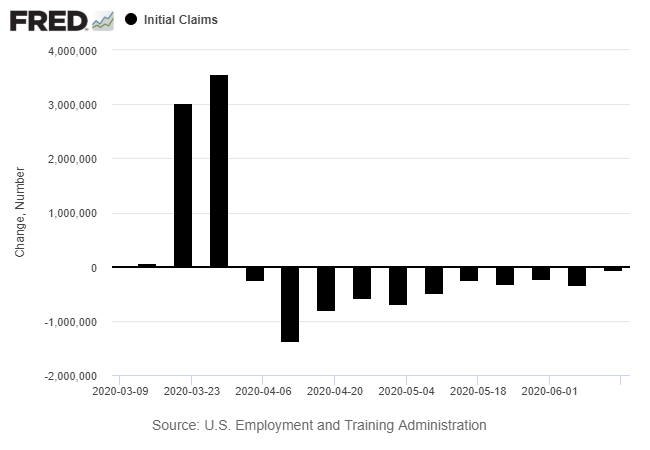
Continuing claims were 20.544M, slightly lower than the prior week, but still very high. This series lags initial claims by one week and is important to monitor rehiring.
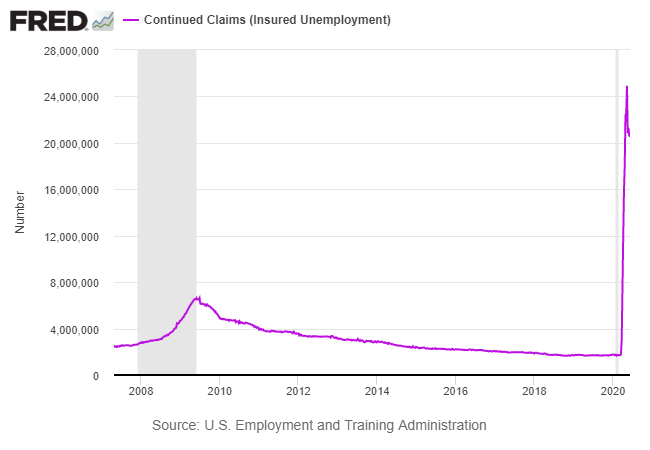
- Declines in state and local tax revenues threaten employment and social services. NY faces a decline of 40%. The average is expected to be 20%. (Bloomberg).
The Ugly
The suicide of a 20-year old student after apparent massive losses in his trading account (Forbes). There are many lessons in this. Requiring new traders to read work by Dr. Brett comes to mind, not as counseling but for a solid grounding in what trading requires.
The Week Ahead
We would all like to know the direction of the market in advance. Good luck with that! Second best is planning what to look for and how to react.
The Calendar
The economic calendar is pretty normal, featuring home sales, jobless claims, personal income and spending, Michigan sentiment, and PCE prices. The final estimate of Q1 GDP is not very interesting – old news and too many events since then. While economic data is getting more attention, attention will focus on the Great Reopening and whether states are avoiding an increase in COVID-19 cases.
Financial media will also find it difficult to resist drifting into coverage of political stories rather than the economy and markets.
Briefing.com has a good U.S. economic calendar for the week. Here are the main U.S. releases.

Next Week’s Theme
Some are comforted by the market rally. Many veteran observers are amazed. It is easy to find “experts” making predictions for extreme market moves. The most important question we face?
How should investors interpret the mixed market and economic messages?
Background
Confusion reigns! Some attribute the market rally to day trading, supported by millennials and sports gamblers with nowhere to get action except Russian table tennis and Korean baseball. This inspires talk of a bubble and an imminent crash by “stock market legends (MarketWatch).
“This is really the real McCoy, this is crazy stuff,” said Grantham during a Wednesday afternoon interview on CNBC that appeared to knock some of the stuffing out of a market that had been drifting along listlessly on Wednesday.
Grantham painted a very dire picture of the investment landscape in the U.S., suggesting that rampant trading by out-of-work investors and speculative fervor around bankrupt companies, including car-rental company Hertz Global Holdings (NYSE:HTZ) Inc. HTZ, -3.88%, reflects a market that may be the most bubblicious he’s seen in his storied career.
Not so fast, says the Pundit-in-Chief. Cramer rails against wealthy money managers for scaring investors out of market with bubble talk
“Our viewers don’t want to be talked out of” investing in stocks and potentially making money, Cramer said. “Jeremy Grantham, he may not want it. He may be so rich he doesn’t need it.”
“Our viewers have every right to capture that money despite many people coming on and saying, ‘No, that’s a bubble,’” Cramer said. “Yes, you can lose money,” he added, but also asked, “Why can’t our viewers make money?”
“Davidson” (via Todd Jones) contends that any excessive valuation is concentrated in a few Mega-Caps driven by momentum investing. He sees economic fundamentals that are “telling a story of a rapid recovery.”
Our mission, should we choose to accept it, is to find some clarity in these extremely mixed messages. I will review each of the leading candidates and then describe my own conclusion.
The Market Itself
Many average investors are reassured by the size of the market rebound. They are encouraged by the segment of the punditry that assures us that the “market is always right.” In particular, investors do not see rising coronavirus cases as the biggest market threat.

Nick Maggiulli’s explanation Is the similarity between the sports bettor demographic and the demographic of Robinhood’s customer base, men between the ages of 25 and 34. He goes on to track specific stocks that are favorites of the newly-minted gurus. These include bankrupt issues like Hertz (HTZ).
People, including the new day traders, are victims of sharks, writes Stefan Cheplick.
I am reminded, in moments like this, at how many people are suddenly experts at financial markets. They are connoisseurs of all things easy and fast money. Out of nowhere, there is a new group of people telling me about “double bottoms” “big bottoms” “stocks to buy” and “these things called call options.”
I find it amazing that we can send rockets to outer space and have them land safely in the middle of the ocean. Or that we are making breakthroughs for Coronavirus cures in record time. But, after a few hundred years, people still get scammed by ads that say How To Get Rich Day Trading.
And then he describes reality.
Most of you reading, however, know it does not work like that. It’s more like:
- Hear stories of billionaire traderz
- Think you becomes billionaire
- Get one big winner it’s too E Z
- Suffer 5 crazy losses
- Blow up account
The Fed
Many investors have developed faith in the Fed after memorizing the out-of-context Marty Zweig line, “Don’t fight the Fed.” Over the last ten years misguided bears whose methods failed blamed it on “liquidity” and the Fed. A generation of analysts learned to interpret any market move as the result of Fed action. At the beginning of this rally the chorus was “The Fed is out of bullets.” Few accepted my statement that they were just getting started. Now everyone is on board, expecting what they call the “Fed put” to provide a floor under the market. This convenient heuristic does not capture the nuances of Fed policy. Chairman Powell warned about a challenging path ahead. Minneapolis Fed President Neel Kashkari sees a possible reversal in job gains if “the virus is not tamed soon.” A second wave is now his base case.
News of the Great Economic Reopening
All 50 states are now in some stage of reopening, nearly always with some restrictions on businesses. There are plenty of pictures of happy people enjoying some freedom from sheltering in place. There are plenty of crowds.
There are also reports of increases in COVID cases. The visual image is one of those who are not sick. The statistical is often regarded as manipulated, error-prone, or focused on small groups of people. Unless and until there is more tangible evidence and a government response, I expect many to downplay COVID-19 as an economic or market threat.
Jeff’s Conclusion
Here is the main explanation for the mixed message: We are trying to squeeze information from data when nothing is there. Let me explain a bit.
- Economic reports are so far from normal that they defy rational explanation. Analysts keep trying because that is what they do. Here is an example. I have often used a chart of the Beveridge Curve to illustrate changes in labor market structure. How would you interpret the most recent version?
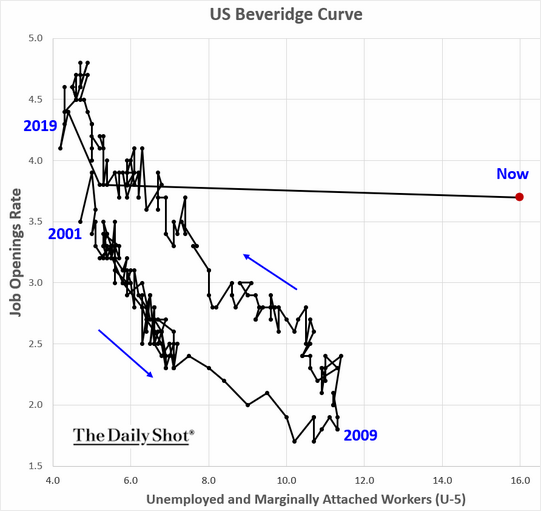
- The interpretation of data is focused on changes in direction, not magnitude or level. Look at the reports on the Empire and Philly Fed indexes. These are diffusion indexes, which means that they ask respondents whether things are better or worse than the prior month. They do this on many questions, but each is a diffusion index. If there is a universal but small improvement from disaster-level conditions, it shows up as a huge reading. What we really want to know is the size of the improvement and whether it is big enough. The diffusion indexes, which I usually do not even report, are just the worst example. Every new green shoot should be evaluated in terms of magnitude and sufficiency. I am happy to review high frequency indicators, but the same problems are present.
- The economy continues to be treated as de-linked from COVID-19. This will continue until some states reimpose restrictions and the economic indicators dip.
I do not see a mixed message. Properly interpreted, economic data show a modest and expected rebound from the lows. Something is to be expected from the economic reopening. Stock prices have become unhinged from a long-term view of economic growth and earnings.
As usual, I have a few more comments in my “Final Thought.”
Ideas for Investors
I have decided to switch the investor section to a separate post. I hope to run it nearly every week. The content will be similar but including more of my personal reactions and some interpretation from our Great Reset project. One of my personal 2020 resolutions was even more emphasis on investor education – not just recommending stocks but learning how to find suitable choices. I have created a resource page where you can join my Great Reset group. You will get updates about what is being studied and can join in the process. There is no charge and no obligation, but I hope you will join in my Wisdom of Crowds surveys. I need more wise participants! The latest survey results are part of my most recent report. The results of our team effort will be published on a regular basis, so you will be joining me in contributing to a greater good.
Quant Corner and Risk Analysis
I have a rule for my investment clients. Think first about your risk. Only then should you consider possible rewards. I monitor many quantitative reports and highlight the best methods in this weekly update, featuring the Indicator Snapshot.

For a description of these sources, check here.
The C-Score increased again. It is a dramatic change in underlying factors which normally provide important indications. This level is an extreme outlier that cannot readily be interpreted. I continue my rating of “Bearish” in the overall outlook for long-term investors.
The Featured Sources:
Bob Dieli: Business cycle analysis via the “C Score”.
Brian Gilmartin: All things earnings, for the overall market as well as many individual companies.
Georg Vrba: Business cycle indicator and market timing tools.
David Moenning: Developer and “keeper” of the Indicator Wall.
Doug Short and Jill Mislinski: Regular updating of an array of indicators, including the very helpful Big Four.
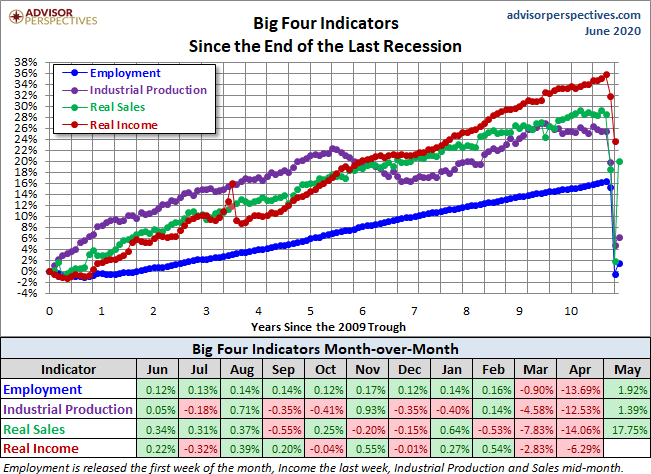
Another way to consider the data is to ask how far each series is from its high.
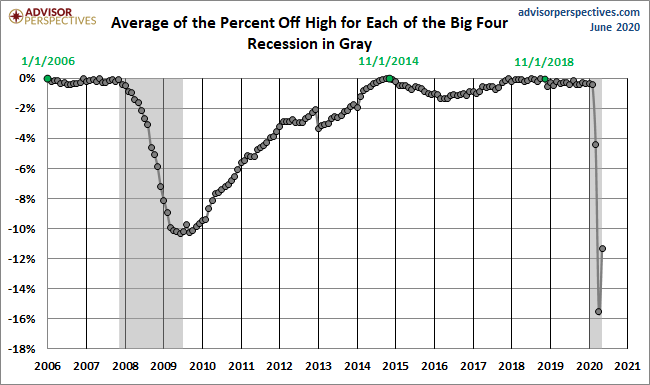
David Moenning adds to his usual indicator update by asking, Is There Any Upside From Here? Using a different earnings analysis from Ned Davis Research, he reaches a pessimistic conclusion. One can argue about the right multiple, but he is considering a forward multiple of 22 on 2021 earnings.
Final Thought
For ten years I stayed on the right side of the market by sticking with proven indicators. This meant ignoring headline “risk” designed to create page views. It meant maintaining perspective when there were some weak economic reports. It meant a focus on corporate earnings and the relative attractiveness of investments.
Most of all, it meant attention to risk. Controlling risk through your asset allocation is not the same thing as trying to time the market. I reduced position size on some occasions, but never made extreme moves. To my surprise I have had to remove some regular market commentators from my “reliably bearish” Twitter list. I guess they are true contrarians, determined to be wrong no matter the circumstances!
The best process is even more important in a bear market. When risks are not obvious and are ignored by many, it is a signal for more caution, not less.
I’m more worried about
- Conflict between China and India.
- Growing political intensity. Goodbye to chances for an infrastructure bill.
- Emotional effects from sheltering at home.
I’m less worried about
- Scientific discovery, where vaccine progress has been rapid and cooperation unprecedented.
- Industrial innovation, with some companies working to adapt to post-recession conditions – a different world for many activities.
